The Sun’s activity cycle, known as the Schwabe cycle, has long been a subject of fascination and intrigue for scientists. This cycle, which lasts approximately 11 years, involves a fluctuation in solar activity levels that is closely tied to sunspots, solar flares, and coronal mass ejections. While the internal mechanisms that drive this cycle are still not fully understood, recent research suggests that external influences, particularly from the planets in our Solar System, may play a significant role.
Planetary Hypothesis Revived
A team of researchers led by physicist Frank Stefani from the Helmholtz-Zentrum Dresden-Rossendorf lab in Germany has put forth a controversial but compelling theory. According to their findings, the gravitational interactions between the Sun and the planets Venus, Earth, and Jupiter could partially explain the Sun’s 11-year activity cycle. This hypothesis, known as the planetary hypothesis, aligns surprisingly well with the timing of Schwabe cycles, raising questions about the extent of planetary influence on the Sun’s dynamics.
Solar Maximum and Minimum
The Sun’s activity reaches its peak during solar maximum, characterized by intense solar phenomena such as flares and mass ejections. On the other hand, solar minimum represents a period of reduced activity. The transition between these phases occurs over several years, with the Sun’s behavior following a cyclic pattern that is closely linked to the Schwabe cycle. As we near solar maximum, scientists are closely monitoring the Sun’s activity to better understand its complex dynamics.
Gravitational Interactions and Rossby Waves
Every 11.07 years, an alignment of Venus, Earth, and Jupiter occurs, leading to a temporary increase in gravitational pull on the Sun. While this effect is relatively weak, it may influence the Sun’s internal dynamics and contribute to the synchronization of its activity cycles. Recent discoveries of giant vortical waves known as Rossby waves in the Sun have provided further support for this hypothesis. These waves, similar to those found in Earth’s atmosphere, could play a key role in transferring energy and influencing the Sun’s behavior.
Stefani and his team have conducted extensive mathematical modeling to investigate the relationship between planetary alignments and solar cycles. They have found that not only does the alignment of Venus, Earth, and Jupiter coincide with the Schwabe cycle, but it also correlates with shorter Rieger cycles. These cycles, characterized by fluctuations in solar flare activity every 150 to 160 days, have been linked to the influence of Rossby waves triggered by planetary alignments. The researchers’ model successfully replicates these cycles, providing further evidence of the planets’ impact on the Sun.
In addition to the Schwabe and Rieger cycles, the researchers have identified another phenomenon known as the Suess-de Vries cycle. This cycle, which occurs every 193 years, is believed to result from the alignment of the Sun’s periodic motion around the Solar System’s center of gravity with the Hale cycle. By incorporating this additional cycle into their model, the researchers have demonstrated the interconnectedness of various solar phenomena and their potential link to planetary influences.
While the findings of Stefani and his team provide compelling evidence for the planetary influence on the Sun’s activity cycles, there is still much to uncover. The complexity of the Sun’s dynamics, coupled with the potential impact of external factors such as planetary interactions, requires ongoing research and investigation. Models, while informative, are only rough approximations that may evolve with new data and insights. The quest to unravel the mysteries of the Sun’s heartbeat continues, pushing scientists to explore new frontiers in solar research.
The Sun’s enigmatic rhythms, driven by a delicate interplay of internal processes and external forces, offer a glimpse into the intricate mechanisms at play in our Solar System. By delving into the planetary influences on the Sun’s activity cycles, scientists are uncovering a deeper understanding of our closest star and its profound connections to the world around us. As we continue to probe the mysteries of the Sun, one thing remains clear: the journey towards unlocking its secrets is a journey of discovery and wonder.



Leave a Reply